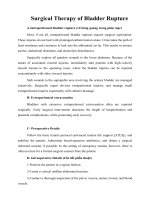Tài liệu Surgical Therapy of Bladder Rupture pdf
Bạn đang xem bản rút gọn của tài liệu. Xem và tải ngay bản đầy đủ của tài liệu tại đây (111.2 KB, 3 trang )
Surgical Therapy of Bladder Rupture
A-Intraperitoneal bladder rupture (vỡ bàng quang trong phúc mạc)
Most, if not all, intraperitoneal bladder ruptures require surgical exploration.
These injuries do not heal with prolonged catheterization alone. Urine takes the path of
least resistance and continues to leak into the abdominal cavity. This results in urinary
ascites, abdominal distention, and electrolyte disturbances.
Surgically explore all gunshot wounds to the lower abdomen. Because of the
nature of associated visceral injuries, immediately take patients with high-velocity
missile trauma to the operating room, where the bladder injuries can be repaired
concomitantly with other visceral injuries.
Stab wounds to the suprapubic area involving the urinary bladder are managed
selectively. Surgically repair obvious intraperitoneal injuries, and manage small
extraperitoneal injuries expectantly with catheter drainage.
B- Extraperitoneal extravasation
Bladders with extensive extraperitoneal extravasation often are repaired
surgically. Early surgical intervention decreases the length of hospitalization and
potential complications, while promoting early recovery.
C- Preoperative Details
Follow the basic trauma protocol (advanced trauma life support [ATLS]), and
stabilize the patient. Administer broad-spectrum antibiotics, and obtain a surgical
informed consent, if possible. In the setting of emergency trauma, however, there is
often no time for a formal surgical consent from the patient.
D- Intraoperative Details (Chi tiết phẫu thuật)
1-Position the patient in a supine fashion.
2-Create a vertical midline abdominal incision.
3-Conduct a thorough inspection of the pelvic viscera, ureters, bowel, and blood
vessels.
4-Note the presence of pelvic hematoma and, if present, leave undisturbed.
5-Bivalve the dome of the bladder.
6-Inspect the interior of the bladder. Foreign bodies such as bone or orthopedic
hardware are often encountered and should be removed.
7-Identify both ureteral orifices and ensure that they are intact.
8-Once the bladder injury is localized, débride all nonviable tissue.
9-High-velocity missile injuries may cause extensive damage to the bladder
tissues.
10-Close the bladder in a watertight fashion using 3 layers with an absorbable
suture. Every effort should be made to protect the closure from any sharp edges or
bony protusions from associated pelvic fractures. Omental fat is often interposed on
the closure as an additional layer.
11-Test the integrity of the closure by inflating the bladder with saline or water.
12-Place a large-bore suprapubic tube through a separate cystotomy site prior to
closing the bladder.
13-Place a pelvic drain in the perivesical space (Đặt một ống dẫn lưu ở vùng
chậu trong khoảng trống quanh bàng quang)
14-Close the abdomen in layers, and apply staples to the skin.
E- Postoperative Details
1-Continue intravenous antibiotics until the patient is discharged.
2-Remove the pelvic drain when the drainage output is minimal, usually within
48-72 hours.
3-Leave in the SPT and indwelling urethral catheters until an x-ray cystogram is
performed.
4-Discharge the patient when he or she shows diet toleration and is ambulatory,
afebrile, and relatively pain-free.
F- Follow-up
1-Instruct the patient to return in 7-10 days for staple removal, and check the
wound at that time.
2-Obtain the x-ray cystogram 10-14 days after surgery.
3-If the cystogram finding is normal, remove the urethral catheter.
4-Perform a voiding trial via the SPT.
5-Remove the SPT when the patient passes the voiding trial.
6-Advise the patient to return to normal activity within 4-6 weeks after surgery.
Do đó chỉ cần đặt một ống dẫn lưu ở vùng túi cùng Douglas là đủ, vì túi cùng
Douglas là vị trí thấp nhất trong ổ bụng của bệnh nhân nơi mà tất cả các chất dịch tự
do trong ổ bụng sẽ dồn vào đó, dù chỉ hiện diện với số lượng ít.
Tham Khảo:
Bladder Trauma: Treatment
Raymond Rackley, MD, Professor of Surgery, Cleveland Clinic Lerner College
of Medicine at CWRU; Co-Section Head, Section of Voiding Dysfunction and Female
Urology, Glickman Urological Institute, Cleveland Clinic Foundation
Sandip P Vasavada, MD, Co-Head, Section of Female Urology, Joint
Appointment, Urological Institute and Department of Gynecology, Co-Director,
Center for Pelvic Neuromodulation, Cleveland Clinic Foundation; Benjamin S Battino,
MD, Consulting Staff, Urology Specialists of Wisconsin









